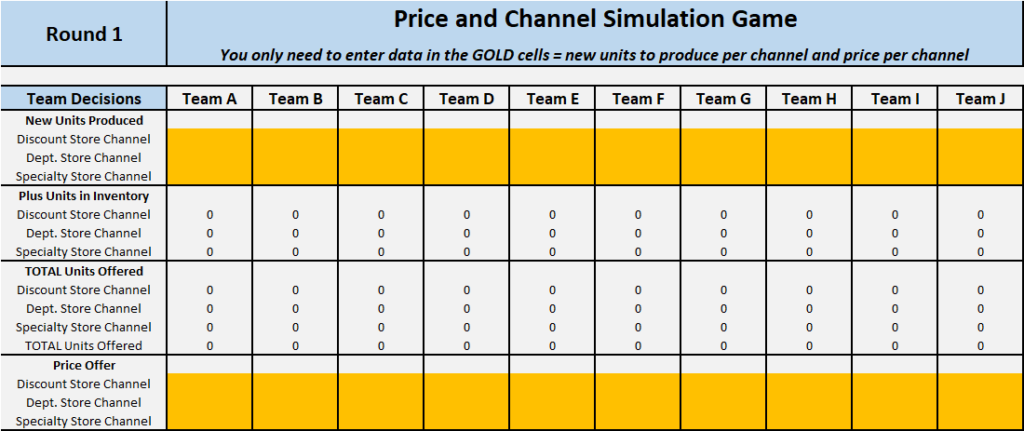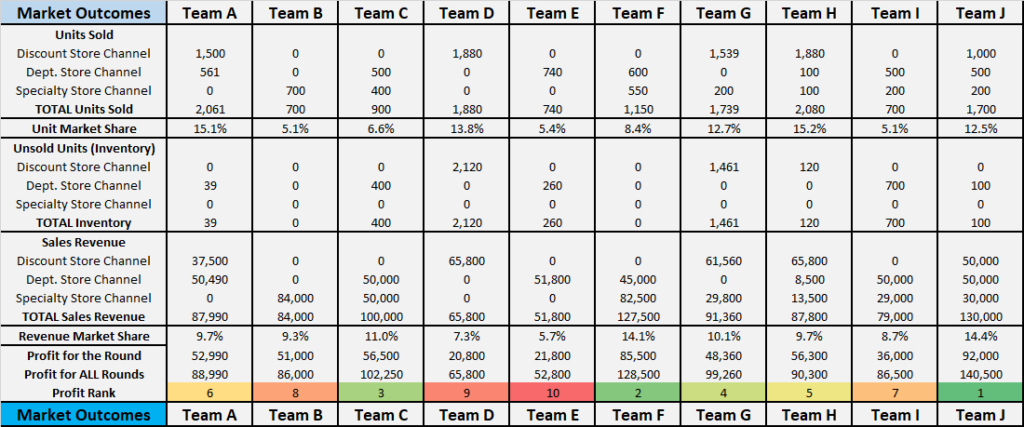Topics
Sim Game, price, place, channels, B2B, relationships
Teaching Notes
This Sim Game is a variation of the interactive (trading) marketing game also available on this website for free download. The game runs on Excel as well, but without the component of physical interaction.
Instead, students make decisions in their teams, which are fed into the sim game template by the instructor, and the results are automatically populated and available immediately. In this marketing sim game, up to 10 students teams compete against each other to maximize their profits over eight rounds.
Each student team represents a manufacturer who has the choice of targeting one, two or three retail channels (namely, discount stores, department stores and/or specialty retail stores).
Free Download
This price/place (channel) focused marketing Sim Game is available for free download here… price-place game-updated
Student Sim Game Instructions (PDF): How the Place-Price Sim Game Works
How the Place-Price Sim Game Works
Please Note: There is an instruction video at the bottom of this page, or you can review these written instructions.
Getting Started
When you open the Excel-based marketing sim game, you will see that there are tabs for all eight rounds, as well as an information tab. The information tab contains the rules and instructions for students.
If students have a basic understanding of Excel, they should be able to follow the rules and start testing their decisions relatively quickly, without too much set-up time. This is an image of the data entry screen for a round of the sim game:
Required Decisions
As indicated at the top of the image, each student team only needs to make an entry (or a decision) in the gold colored cells. And each team only needs to put in six numbers, which are:
- the number of units they wish to produce for the discount store channel
- the number of units they wish to produce for the department store channel
- the number of units they wish to produce for the specialty store channel
- the price of the units for the discount store channel
- the price of the units for the department store channel
- the price of the units for the specialty store channel
They do NOT need to compete in every channel and may choose to specialize in one or two channels only. The sim game spreadsheet calculated automatically, so teams could put pretend decisions in for their competitor teams and work out the optimal decisions.
Sim Game Rules
The rules for playing the game are provided within the spreadsheet itself, which can be made available for more senior student cohorts. But they are repeated here for completeness:
Set-up You play in teams against other teams – up to ten teams in total and the game runs up to 8 rounds
Your Goal Your objective is to maximize profits over the 8 rounds (or earlier if playing a shorter version)
Decisions You have three main decisions to make:
- Which of the three channels to utilize (discount, department and/or specialty stores)?
- What quantity of product for each channel to produce?
- What price will you offer each of your product lines to your targeted retailers?
Unit Costs The unit costs for your products are:
- $10 for products in the discount store channel
- $25 for products in the department store channel
- $40 for products in the specialty store channel
Other Costs and Inventory
- You also have fixed costs of $5,000 per round
- Any products not sold in that round go into your inventory for sales next round
- You incur the production costs in that round whether or not they are sold
- You incur an inventory holding cost of 10% of the stock value
Your Budget
- In round 1 you have a starting budget of $25,000, which also must cover your fixed costs
- In later rounds, your budget is your accumulated products (or a minimum of $25,000)
Price Elasticity
- Each channel, and its consumers, have varying degrees of price elasticity
- Products in the discount store channel = strong price elasticity
- Products in the department store channel = Moderate price elasticity
- Products in the specialty store channel = Slightly price elastic
- Please refer to the ‘Demand’ tab for more detail on market demand
Important note: price elasticity only becomes a factor when supply exceeds demand – take care!
Price Ranges
- Price points (that you can charge) vary by channel as well…
- Products in the discount store channel = $25 to $50
- Products in the department store channel = $50 to $100
- Products in the specialty store channel = $100 to $150
Data Entry and Checks
- You only need to enter unit quantities per channel and price per channel
- The sim game automatically calculates all the other numbers
- Important: You should see two OK symbols if the data is correctly entered and within budget
- Remember to move to the next Round tab for each decision
Making Decisions
- The sim game – as it allows for automatic calculation, is an excellent tool for scenario testing
- In other words, play around with potential decisions before finalizing
Final Tips
- This is a sim game – it reflects your market reality – follow the numbers/data – not guesses!
- Have fun, use your team strengths, and learn some marketing concepts along the way.
Sim Game Outcomes
As mentioned, the sim game template automatically produces the outcomes – there are no calculations that need to be made outside of the spreadsheet.
In addition, spreadsheet has a built-in “data check” to ensure that all entries have been put in on a valid basis. Here is a sample of the output that you will see – this shows a sim Game for 10 student teams in round two:
These market outcomes are produced automatically as the students’ decisions are entered into the template. As you can see, the sim game automatically calculates:
- the number of units sold for each team by channel,
- the number of unsold units (which becomes inventory, which carries a holding cost),
- their revenue,
- market shares, and
- the all-important profit number and their profit ranking
How-to-Play Instructional Video
Other Sim Games
Once your students have played this game – perhaps more than once – check out the free interactive marketing sim game – it is conceptually similar, but with the added challenge (and fun) of student teams trading with each other in a “marketplace” and setting their own prices.
Also see our full list of available sim games, including:
- New Product Evaluation Game
- Average Cost Curves Game
- Pizza Store Design Game
- Restaurant Pricing Game
- Price-Place Marketing Sim Game
- Digital Escape Rooms for Teaching Marketing
Academic Reading

